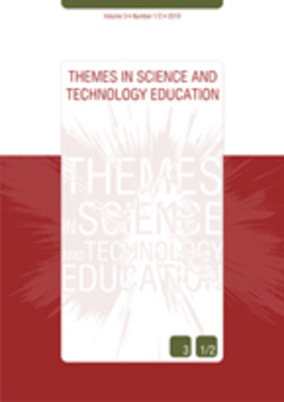Investigating the differences between girls and boys regarding the factors of frustration, boredom and insecurity they experience during science lessons
Part of : Themes in science and technology education ; Vol.7, No.1, 2014, pages 35-45
Issue:
Pages:
35-45
Abstract:
Science, technology, engineering and mathematics (STEM) are subjects comprising knowledge whose schooling is essential for every country striving after long-term economic success. Despite the already existing shortage of skilled labour within the mathematic-technical-scientific professional field, men still dominate the respective subjects and jobs. The loss of female talent as a consequence of insufficient support is inexcusable from both an economic and social point of view. This is why affirmative action should be taken during schooling years in order to prevent girls from turning their backs on STEM subjects. Bielefeld University’s coeducational science project ‘Kolumbus-Kids’ is a programme to support gifted students in general, and especially girls. This article presents both the project and a recent study investigating how girls show differences from boys when it comes to experiencing frustration, boredom and insecurity during science lessons. These emotions highly influence a person’s activation, interest and motivation and are the point of intersection for cognitive processes which makes it important to deal with them sensitively. On the basis of theoretical background information on gender related differences, the project is designed to support gifted children and girls when it comes to STEM subjects. As found in this article, the underrepresentation of women in STEM-related university classes is a problem that has to be solved not only because of the skilled labour shortage. The study shows that specifically designed tutoring projects like ‘Kolumbus-Kids’ contribute highly to this solution. They are able to ignite and keep the interest in STEM-related subjects alive and they also lower frustration, boredom and insecurity in the same regard. One of the most important prerequisites for success is to know the girls’ interests and what the possible problems are in order to better support them.
Subject:
Subject (LC):
Keywords:
STEM subjects, science project, coeducation, gender differences
References (1):
- Anger, C., Demary, V., Koppel, O., & Plünnecke, A. (2013). MINT-Frühlingsreport 2013. Innovationskraft, Aufstiegschancen und demografische Herausforderung. Institut der deutschen Wirtschaft Köln. Retrieved 10 June 2014, from http://www.iwkoeln.de/de/studien/gutachten/beitrag/christina-anger-vera-demary-oliver-koppel-axel-pluennecke-mint-fruehjahrsreport-2013-111714.Bach, G. (1996). Pädagogische Psychologie. Weinheim, Germany: Psychologie Verlagsunion. BFBF/Bundesministerium für Bildung und Forschung (2013). Qualifizierungsinitiativen. Chancen für Frauen. Retrieved 5 June 2014, from http://www.bmbf.de/de/12563.php.Bischof-Köhler, D. (2006). Von Natur aus anders. Die Psychologie der Geschlechtsunterschiede (Naturally different. Psychology of gender differences). Stuttgart, Germany: Kohlhammer.Dietzold, M. (2003). Geschlechterverhältnisse in mathematischen und naturwissenschaftlichen Lernfeldern: Eine international vergleichende Untersuchung. Hamburg: Verlag Dr. Kovac.Edlinger, H., & Hascher, T. (2008). Von der Stimmungs- zur Unterrichtsforschung: Überlegungen zur Wirksamkeit von Emotionen auf schulisches Lernen und Leisten. Unterrichtswissenschaft, 36(1), 55-70.Faulstich-Wieland, H. (2004). Mädchen und Naturwissenschaften in der Schule. Homepage for the SINUS-program of Bayreuth University. Retrieved 1 June 2014, fromhttp://sinus-transfer.uni-bayreuth.de/fileadmin/MaterialienBT/Expertise.pdf.Gonzales, H. B., & Kuenzi, J. J. (2012). Science, Technology, Engineering, and Mathematics (STEM) Education: A Primer. CRS Report for Congress. Congressional Research Service. Retrieved 6 June 2014, from http://www.fas.org/sgp/crs/misc/R42642.pdf.Gramm, A., Bohne, J., & Stephan, H. (1992). Vom Sachunterricht zum Fachunterricht. Biologie, Chemie, Physik, technisches Werken. Frankfurt am Main, Germany: Lang.Hahn, B. (2010). Mädchenförderung in den MINT-Fächern.Get-it: Mädchen fördern. Retrieved 2 June 2014, from http://www.get-it.tu-berlin.de/menue/maedchen_und_mint/maedchen_foerdern.Harker, R. (2000). Achievement, gender and the single-sex/coed debate. British Journal of Sociology of Education, 21, 203-218.Hascher, T. (2005). Emotionen im Schulalltag. Wirkungen und Regulationsformen. Zeitschrift für Pädagogik, 51, 610-623.Heller, K. A., & Perleth, C. (2000). Kognitiver Fähigkeitstest für 4. bis 12. Klassen, Revision. Göttingen, Germany: Beltz Test GmbH.Lorge, I., & Thorndike, R. M. (1954). Lorge-Thorndike intelligence tests. Boston: Houghton Mifflin.NAGC (2013). What is Giftedness? National Association for Gifted Children. Retrieved 3 June 2014, from http://www.nagc.org/WhatisGiftedness.aspx.Piaget, J. (1975). Nachahmung, Spiel und Traum. Stuttgart, Germany: Klett.Stöger, H., Ziegler, A., & Heilemann, M. (2012). Mädchen und Frauen in MINT. Bedingungen von Geschlechterunterschieden und Interventionsmöglichkeiten. Berlin: LIT Verlag.Thorndike, R. L., Hagen, E., & Lorge, I. (1954-1974). Cognitive Abilities Test. Chicago, IL: Riverside Publishing.Toglia, T.V. (2013). Gender equity issues in CTE and STEM education. Tech Directions, 72(7), 14-17.Van de Gaer, E., Pustjens, H., Van Damme, J., & De Munter, A. (2004). Effects of single-sex versus co-educational classes and schools on gender differences in progress in language and mathematics achievement. British Journal of Sociology of Education, 25, 307-322.Watermeyer, R. (2012). Confirming the legitimacy of female participation in STEM: Evaluation of a UK STEM initiative for girls. British Journal of Sociology of Education, 33(5), 679-700.Wegner, C. (2008). Entwicklung und Evaluation des Projekts ‘Kolumbus-Kids’ zur Förderung begabter SchülerInnen in den Naturwissenschaften (Development and evaluation of the project ‘Kolumbus-Kids’ for tutoring scientifically gifted students). Unpublished doctoral dissertation. Bielefeld, Germany: Universität Bielefeld.Wegner, C., & Minnaert, L. (2012). Promoting future scientists: the project Kolumbus-Kids. Education in Science, 249, 20–21.Wegner, C., Minnaert, L., & Strehlke, F. (2013). The Kolumbus-Kids project in Germany for gifted children. Primary Science, 130, 16–20.Wegner, C., Homann, W., Strehlke, F., & Borgmann, A. (2014). E-Learning and the use of New Technologies in the ‘Kolumbus-Kids’ project in Germany. Educational Technology - The Magazine for Managers of Change in Education, 54(1), 35–37.Windaus, A., Mokhonko, S., & Nickolaus, R. (2011). Evaluationsstudie zu den Effekten außerschulischer Fördermaßnahmen im MINT-Bereich. In U. Faßhauer, Aff, J., Fürstenau, B. & Wuttke, E. (eds.), Lehr-Lernforschung und Professionalisierung. Perspektiven der Berufsbildungsforschung (pp. 75-86). Leverkusen/Berlin, Germany: Verlag Barbara Budrich.




